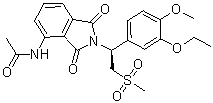| Cas No.: | 608141-41-9 |
| Chemical Name: | Apremilast |
| Synonyms: | ApreMilast;(S)-N-(2-(1-(3-Ethoxy-4-methoxyphenyl)-2-(methylsulfonyl)ethyl)-1,3-dioxoisoindolin-4-yl)acetamide;ApreMilast,CC-10004;AcetaMide, N-[2-[(1S)-1-(3-ethoxy-4-Methoxyphenyl)-2-(Methylsulfonyl)ethyl]-2,3-dihydro-1,3-dioxo-1H-isoindol-4-yl]-;Appleton West;(S)-N-(2-(1-(3-Ethoxy-4-methoxyphenyl)-2-(methylsulfonyl)ethyl)-1,3-dioxoisoindolin-4-yl)acetamide Apremilast (CC-10004;(S)-N-(2-(1-(3-Ethoxy-4-methoxyphenyl)-2-(methylsulfonyl)ethyl)-1,3-dioxoisoindolin-4-yl);N-[2-[(1S)-1-(3ethoxy-4-methoxyphenyl)-2-(methylsulfonyl)ethyl]-2,3-dihydro-1,3-dioxo-1H-isoindol-4-yl]acetamide;Apremilast QCR-202 CC10004;1,3-Dioxo-2-isoindolineaceticacid;Apremilast (CC-10004);ApreMilast, (S)-2-[1-(3-Ethoxy-4-Methoxyphenyl)-2-Methylsulfonylethyl]-4-acetylaMinoisoindoline-1,3-dione;LCZ696;N-[2-[(1S)-1-(3-ethoxy-4-methoxyphenyl)-2-methylsulfonylethyl]-1,3-dioxoisoindol-4-yl]acetamide;(S)-2-[1-(3-Ethoxy-4-methoxyphenyl)-2-methylsulfonylethyl]-4-acetylaminoisoindoline-1,3-dione;CC10004;CC-10004;N-{2-[(1S)-1-(3-Ethoxy-4-methoxyphenyl)-2-(methylsulfonyl)ethyl]-1,3-dioxo-2,3-dihydro-1H-isoindol-4-yl}acetamide;Unii-up7qbp99pn;Apremilast(CC-10004);OTEZLA;CC 10004;apremilastum;UP7QBP99PN;C22H24N2O7S;Apremilast [USAN:INN];Otezla (TN);Apremilast (JAN/USAN);Apremilast/CC 10004/;GTPL7372;QC |
| SMILES: | CC(NC1=CC=CC(C(N2[C@@H](C3=CC=C(OC)C(OCC)=C3)CS(=O)(C)=O)=O)=C1C2=O)=O |
| Formula: | C22H24N2O7S |
| M.Wt: | 460.5002 |
| Purity: | >98% |
| Sotrage: | 2 years -20°C Powder, 2 weeks 4°C in DMSO, 6 months -80°C in DMSO |
| Description: | Apremilast is an orally available inhibitor of type-4 cyclic nucleotide phosphodiesterase (PDE-4) with an IC50 of 74 nM. |
| In Vivo: | Apremilast, orally administered (5 mg/kg), significantly inhibits TNF-α production in the air pouch by 39 % (61±6 % of vehicle, P <0.001) and diminishes (by 28 %) the number of leukocytes present (72±12 % of vehicle, P<0.05). In agreement, immunohistologic analysis shows that neutrophil accumulation in the air pouch membrane is dramatically reduced by Apremilast. In the murine air pouch model, both Apremilast and methotrexate (MTX) significantly inhibit leukocyte infiltration, while Apremilast, but not MTX, significantly inhibits TNF-α release. The addition of MTX (1 mg/kg) to Apremilast (5 mg/kg) yields no more inhibition of leukocyte infiltration or TNF-α release than with Apremilast alone[1]. Apremilast is a novel, oral PDE4 inhibitor that has been shown to regulate inflammatory mediators. After oral administration of Apremilast, a mean maximum plasma concentration (Cmax) is found to be 67.00±14.87 ng/mL. The plasma concentration of Apremilast decreases rapidly and is eliminated from plasma with a terminal half-life of 0.92±0.46 h[2] |
| In Vitro: | Apremilast inhibits TNF-α release by lipopolysaccharide (LPS) with an IC50 of 104 nM (pIC50=6.98±0.2), which almost exactly replicates previous reported TNF-α inhibition by Apremilast on peripheral blood mononuclear cells (PBMCs) (IC50=110 nM) and which is similar to the potency of Apremilast for PDE4 enzymatic inhibition (IC50=74 nM). These results are clearly consistent with the hypothesis that Apremilast inhibits TNF-α by increasing intracellular cAMP levels. PKA, Epac1 and Epac2 knockdowns prevented TNF-α inhibition and IL-10 stimulation by Apremilast[1]. |

 DC Chemicals' products qualify for U.S. tariff exemptions. We guarantee no price increases due to customs duties and maintain stable supply, continuing to deliver reliable research solutions to our American clients.
DC Chemicals' products qualify for U.S. tariff exemptions. We guarantee no price increases due to customs duties and maintain stable supply, continuing to deliver reliable research solutions to our American clients.





















